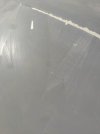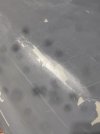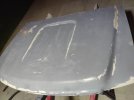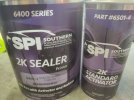Over the past few months, I have been teaching myself how to paint and do body work as I have always wanted to learn how to do it. I've also been reading a lot of posts here and pickup up a lot from it as well. Never heard of any SPI products until I got some primer at my local store, and I was amazed of how helpful they were. I've never seen a company where you could just call a non 800 number and someone picks right up and you can talk to them, especially given that I am just some non-professional guy in his garage who won't be buying near the amount of product that a body shop or professional would.
With that said I am trying to paint a 2011 GMC Sierra Denali in 800J white diamond pearl, which I have learned is probably the most difficult color to learn on. It also has OEM peeling paint issues like a lot of the other trucks like this one. I took about 70% of the hood down to bare metal with an 80 grit fiber resin disk after scraping all the peeling paint I could tell that was not adhering. I then sprayed some SPI epoxy, followed by some 2k acrylic filler primer, then sanded the filler primer to 400 if I remember correctly. So the day I was going to paint the base on I used the 4101 grey sealer with one wet coat. But I had noticed it looked a little rough, and I see others on this forum have talked about that and how it works a lot better at 4:1:2 like the data sheet says. I can't remember if I reduced it a little more than 4:1:1 or what, but I was concerned about the rough texture showing in the base so I lightly wet sanded it after a hour or so with a maroon (supposedly 600 grit) scuff pad. I then sprayed the base, midcoat, and clear.
Now about a month later I am sanding the clear back down on it to 600 grit since I am going to respray it with a different color basecoat, since I wasn't satisfied with the color match I got the first round. Then I notice a small flake chip off while trying to fix a high spot in the finish. I got my razor and decided to test it to see if it would chip off any more and it went the whole entire length of the hood. Turns out 98% of the basecoat peeled right off to reveal the sealer underneath.
From my research it looks to me like the only reasons why paint should ever peel is either contamination or insufficient sanding. Now I understand this is sealer so it is designed to spray wet on wet as long as it's within the 4-hour time window. My guess is that (it's hard to remember it was about a month ago since I first painted it) maybe I didn't have the hood fully dry from water after wet sanding it with the scuff pad, or maybe I damaged it somehow by wet sanding it and maybe wasn't supposed to since it is sealer. I hope I don't have to redo the doors and quarter panel I did with sealer as well. The sealer definately has very good adhesion with the 2k fillter primer below it and you can't scrape it with the razor and it will feather out nicely. Does anyone else have any ideas what I could have done wrong? The base was a Pro Spray just mixed with reducer 1:1 with no activator/hardener. I attached some pictures after I used a razor and peeled the basecoat off and you can see the tiny spots where it was adhearing better, I just can't think of what made thoes spots any different that they held on so much better. The base peeled clean off in most areas like butter. Thanks for the help.
With that said I am trying to paint a 2011 GMC Sierra Denali in 800J white diamond pearl, which I have learned is probably the most difficult color to learn on. It also has OEM peeling paint issues like a lot of the other trucks like this one. I took about 70% of the hood down to bare metal with an 80 grit fiber resin disk after scraping all the peeling paint I could tell that was not adhering. I then sprayed some SPI epoxy, followed by some 2k acrylic filler primer, then sanded the filler primer to 400 if I remember correctly. So the day I was going to paint the base on I used the 4101 grey sealer with one wet coat. But I had noticed it looked a little rough, and I see others on this forum have talked about that and how it works a lot better at 4:1:2 like the data sheet says. I can't remember if I reduced it a little more than 4:1:1 or what, but I was concerned about the rough texture showing in the base so I lightly wet sanded it after a hour or so with a maroon (supposedly 600 grit) scuff pad. I then sprayed the base, midcoat, and clear.
Now about a month later I am sanding the clear back down on it to 600 grit since I am going to respray it with a different color basecoat, since I wasn't satisfied with the color match I got the first round. Then I notice a small flake chip off while trying to fix a high spot in the finish. I got my razor and decided to test it to see if it would chip off any more and it went the whole entire length of the hood. Turns out 98% of the basecoat peeled right off to reveal the sealer underneath.
From my research it looks to me like the only reasons why paint should ever peel is either contamination or insufficient sanding. Now I understand this is sealer so it is designed to spray wet on wet as long as it's within the 4-hour time window. My guess is that (it's hard to remember it was about a month ago since I first painted it) maybe I didn't have the hood fully dry from water after wet sanding it with the scuff pad, or maybe I damaged it somehow by wet sanding it and maybe wasn't supposed to since it is sealer. I hope I don't have to redo the doors and quarter panel I did with sealer as well. The sealer definately has very good adhesion with the 2k fillter primer below it and you can't scrape it with the razor and it will feather out nicely. Does anyone else have any ideas what I could have done wrong? The base was a Pro Spray just mixed with reducer 1:1 with no activator/hardener. I attached some pictures after I used a razor and peeled the basecoat off and you can see the tiny spots where it was adhearing better, I just can't think of what made thoes spots any different that they held on so much better. The base peeled clean off in most areas like butter. Thanks for the help.




